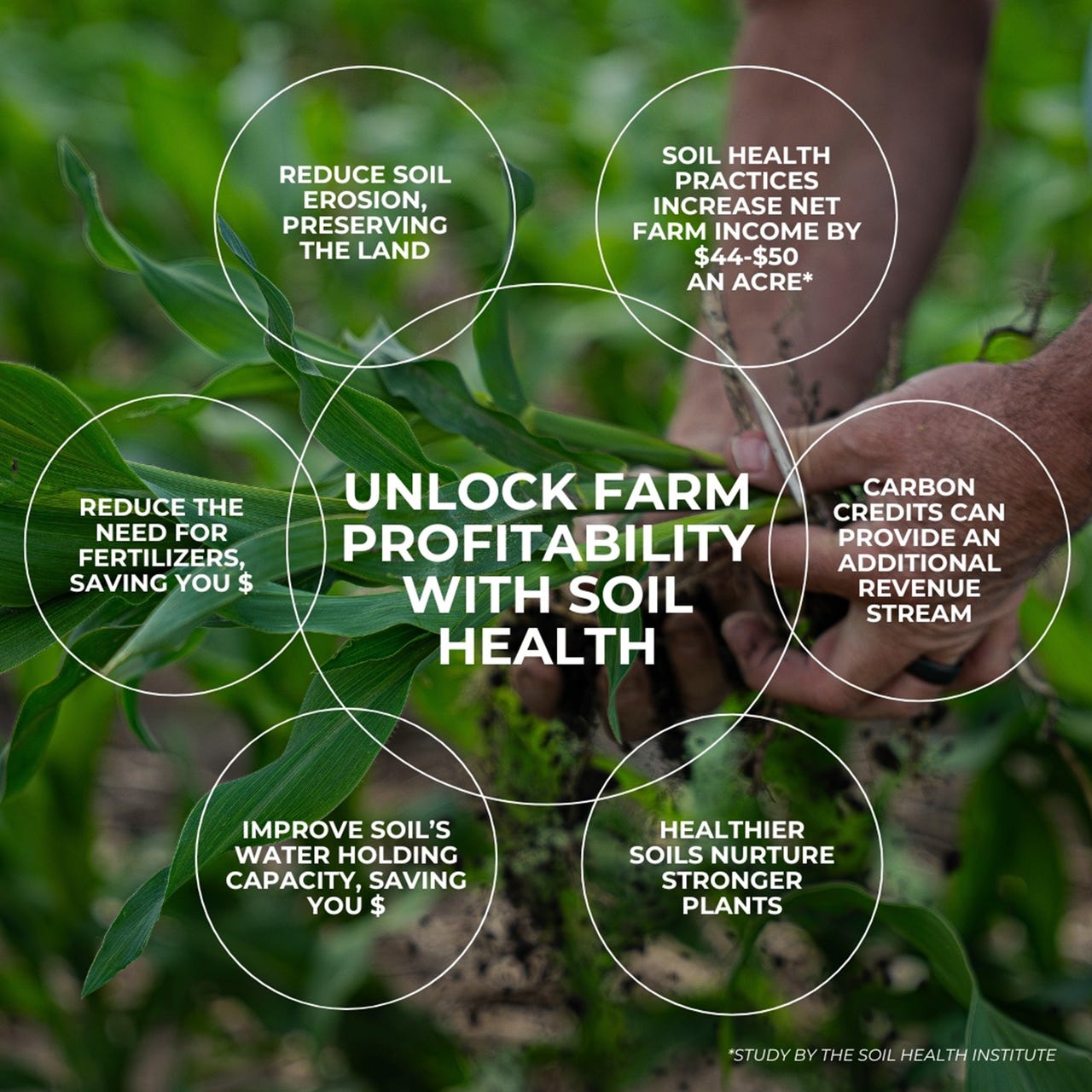-1.jpg?width=1024&height=512&name=Blog%20headers%20%232%20(21)-1.jpg)
What if your soil could do more than grow crops – what if it could build your legacy? American farmers are turning to soil health not just to reduce costs and improve yields, but to create thriving, resilient farms that regenerate value year after year, it’s about leaving the soil better than we inherited it.
Maintaining healthy soil is more than an agronomic best practice – it's a strategy for unlocking consistent profitability on your farm. Thrivability runs deeper than sustainability - it's about actively regenerating your land, improving profitability, and ensuring your farm doesn’t just survive, but flourishes.
It's about building something enduring. When we invest in soil health, we’re creating a legacy. We’re giving the next generation of farmers richer soil, stronger ecosystems, and more profitable land than when we inherited it. That's the power of a thriving farm.
When soil health practices are stacked together—like cover crops, no-till farming, crop rotation, and microbials—their combined effect is exponential. The result? Living soils that feed your crops, support your bottom line, and strengthen your farm’s future.
According to a study by the Soil Health Institute, implementing these practices can increase net farm income by $51.60 per acre annually for corn and $44.89 per acre for soybeans.
Healthy Soils Build Carbon
Soil isn’t just dirt—it’s a living ecosystem, a carbon vault, and a powerful engine of farm profitability. Healthy soils pull carbon from the atmosphere and channel it to the rootzone, where it fuels crop growth and resilience. As carbon levels in the soil rise, so does productivity. And beyond agronomic benefits, carbon-rich soils can unlock new revenue streams, with carbon credit estimates ranging from $10 to $100 per acre annually.

Soil Health Practices
Microbials: Nature’s Workforce
Healthy soil starts with microbes – the invisible workforce that powers your land. Bacteria, fungi, protists, and other microbes drive soil functionality, including fertilizer efficiency, soil structure, organic matter, water-holding capacity, and more.
They also make no-till farming possible by breaking down residue and cycling nutrients. In healthy soils, nearly every nutrient your crop consumes passes through a microbe first.
Adding microbial inoculants to your soil boosts the population of beneficial microbes, improving soil health and plant growth. Holganix Bio 800+ contains a consortium of over 800 species of beneficial microbes that enhance soil health, reduce the need for fertilizer by up to 40%, break down residue, and improve crop yields.
.jpg?width=2000&height=706&name=New%20one%20-%207.21.2025%20(3).jpg)
Microbials: Nature’s Workforce
Healthy soil starts with microbes – the invisible workforce that powers your land. Bacteria, fungi, protists, and other microbes drive soil functionality, including fertilizer efficiency, soil structure, organic matter, water-holding capacity, and more.
They also make no-till farming possible by breaking down residue and cycling nutrients. In healthy soils, nearly every nutrient your crop consumes passes through a microbe first.
Adding microbial inoculants to your soil boosts the population of beneficial microbes, improving soil health and plant growth. Holganix Bio 800+ contains a consortium of over 800 species of beneficial microbes that enhance soil health, reduce the need for fertilizer by up to 40%, break down residue, and improve crop yields.
No-Till Farming: A gentle way to work with nature
No-till farming keeps plant residue on the soil surface, which protects against erosion, retains moisture, and provides a habitat for microbes. These residues become food for microbes, which break them down into usable nutrients.
Research shows that no-till farming increases soil organic matter in the top several inches of the soil. Further, farmers implementing no-till can significantly reduce soil erosion rates. According to a study by the University of Illinois, completely shifting to no-till may reduce soil loss and sediment yield by more than 70%.
Cover Crops: Living Armor for Soil
Cover crops act as living armor, preventing soil erosion, enhancing structure, and increasing nutrient content. Studies have found that cover crops reduce soil loss by up to 75% when compared to fallowed fields. Their roots also create natural channels in the soil, improving water infiltration and reducing runoff—by as much as 90% in some studies. They work while you rest.
Crop Rotation: Nature’s Built-In Resilience
Rotating crops helps break pest and disease cycles, and increases nutrient availability. One USDA Agricultural Research Service study demonstrated that rotating crops increased long-term yield stability and decreased crop losses during a drought by 14-90%. Rotation isn’t just variety - it’s resilience.
Water Management: Thriving Through Drought
Healthy, functional soils hold water like a sponge. Each increase in organic matter can store up to 20,000 gallons of water per acre. During dry periods, this water reserve is critical for sustaining crops without extra inputs.
The Stacking Effect
Each practice has its benefits—but stack them together, and something powerful happens.
Cover crops in a no-till system add organic matter while preserving soil structure. Microbials enhance the fertility and moisture retention of that same soil. Over time, these practices build a self-sustaining ecosystem that reduces input needs, increases yields, and strengthens profitability.
Healthy soil leads to healthier crops—more resistant to pests, more efficient with water, and more reliable through seasonal stress. It’s so much more than sustainability; it’s thrivability.
From Maintenance to Momentum
When you commit to building soil health, you're not just preserving your land—you’re regenerating it. You’re unlocking year-round profitability, resilience, and opportunity.
And more importantly, you're leaving the soil—and the farm—better for the next generation.
Now is the time to thrive.
 |
September 4, 2025
|
1:00 PM
|
September 4, 2025
|
1:00 PM
-2.jpg)
.jpg)

.jpg)
-1.jpg)
-1.jpg)
-2.jpg)
.jpg)

.jpg)
-1.jpg)
-1.jpg)



-1.jpg?width=1024&height=512&name=Blog%20headers%20%232%20(21)-1.jpg)

.jpg?width=2000&height=706&name=New%20one%20-%207.21.2025%20(3).jpg)
.webp)
-1%20(1).webp)
-831535-2.webp)





.jpg)
.png)